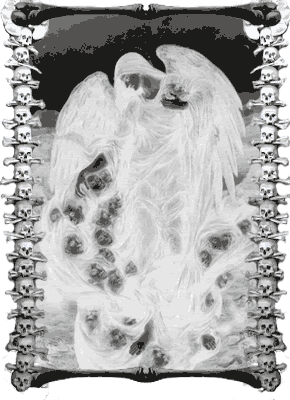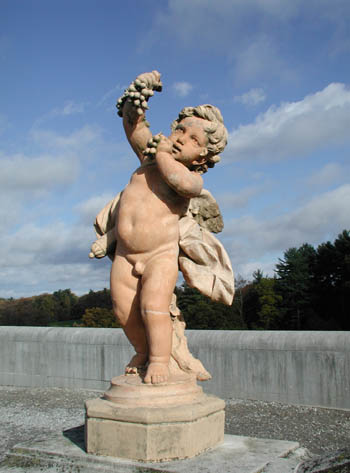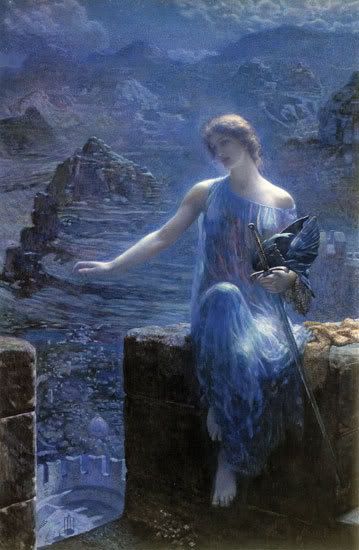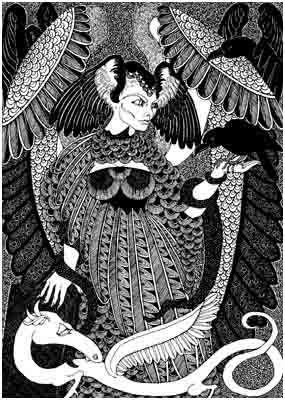ProfessorChaos
New member
Warning! This post contains spoilers for Raiders of the Lost Ark. If you haven't seen the movie already, you may not want to ready any further.
(End of Spoiler Warning...)
Ever since I first saw Raiders of the Lost Ark as a kid, I always wondered what the apparitions that came out of the Ark were meant to be. Recently, I've done some research and discovered their precise idenity. Here we go...
(Cue the Indy Theme!)
My first stop was the official Indiana Jones Wiki, and the entry for the Ark:
http://indianajones.wikia.com/wiki/Ark_of_the_Covenant
There, I discovered this revealing statement: "Ghostly apparitions emerged from within and swarmed playfully about the Nazis before adopting a more sinister tone; the spirits transformed their appearances from angelic beings into monstrous demons. Lightning burst through the soldiers and their souls were taken to be judged. Indy and Marion Ravenwood, who closed their eyes and looked away from the Ark, were spared from God's anger."
So, the big clues here were that these "Ghosts" are actually "Angelic Beings" that can turn into "Monstrous Demons". Next, I thought I would check out what the original screenplays and scripts had to say about this sequence, which led me to two extremely informative pages that you can find here:
http://www.scriptologist.com/Magazine/Film_Analysis/Raiders/raiders.html
and here:
http://www.scriptologist.com/Store/Screenplay_Coverage_Services/Sample_Coverage/sample_coverage.html
Originally, they wanted to have "The Angel of Death" emerge from the Ark and kill Belloq and the Nazis with "fire and bolts of lightning". So, in the end it seems that the angel which killed Belloq was supposed to be the Angel of Death. Hence the reason why it's beautiful face turned dark and skeletal. But that didn't say anything about the other angels that were flying around. Next I did a little bit of religious detective work, which revealed everything at last!
The main attributes of these angels consists of the following, that we know:
1. They are representative of God's Wrath
2. Their powers are related to fire as well as lightning
3. They are as demonic as they are angelic
In Biblical tradition the angels known as the Seraphim are described like this:
"Seraph literally means "burning ones" in the Hebrew (Sarap, 'to burn'). A word of the same spelling is used of snakes (e.g. Isaiah 30v6), misleading some to think them serpent-guardians. The word 'seraphim' Isaiah uses has no definite article; it is a description not a title. Note also how their ministry to Isaiah involves 'burning'."
This came from standard Wikipedia's entry for "Seraph", and was probably the most telling piece of evidence I found. In Raiders of the Lost Ark, those who stood closest to the Ark were burned, in Belloq's case even to the point of exploding. Plus, the angels sort of turned into a whirlwind of fire, which then sucked everything up into the sky with the Ark before hurling the Ark back down again and slamming it's lid shut. So, these angels literally could have been called the "burning ones" in the literal sense of the world. Also, Seraphs are said to be the angels closest to the throne of Jehovah / God, so what better angels to send to dish out God's wrath than those closest to God?
Plus, let's think about the serpent-guadians reference. Isn't it ironic that the Ark was put into the Well of Souls, where it was literally guarded by snakes? Perhaps the Egyptians knew about the Seraphim and intended this to be a warning to the learned about the true power of the Ark and what it contains.
Just as people were misled into believing the Seraphim were serpent-beings, perhaps those who stumbled upon the Well of Souls could be misled into thinking the snakes were the Ark's only guardians, when the true guardians of the Ark lay within the relic itself. A bit philosophical, but it does fit the facts.
Lastly, to the ancient Hebrew, all angels could be both angelic and demonic, capable of both blessing and punishing (and punishing in truly terrible ways).
Now, for the final piece of the puzzle: the name of the Angel of Death. Yes, it turns out this angel has a proper name. That name is "Azrael". You can read more about Azrael on this very interesting standard Wikipedia entry:
http://en.wikipedia.org/wiki/Azrael
Azrael's name comes from Arabic and Hebrew, where "el" is used as a kind of last name for all angels, to indicate they are children of "El", which is an old Canaanite name for God. So here we have "Azra, child of El". So, we can now say with certainty that Belloq was killed by Azrael. And, finally, my quest for the answer to the question of what those beings in the Ark were is complete.
And they say the Indiana Jones films as just action and not that deep? Ha! I guess this proves that there is a great deal of hidden depth to these movies.
You know... you have to admire a movie about archeology that is done *so* exciting that it prompts you to do some real-life research. That's one reason why Raiders of the Lost Ark will always be one of the best movies of it's kind ever made, if not *the* best. It isn't just a lot of action... it's also inspiring!
(End of Spoiler Warning...)
Ever since I first saw Raiders of the Lost Ark as a kid, I always wondered what the apparitions that came out of the Ark were meant to be. Recently, I've done some research and discovered their precise idenity. Here we go...
(Cue the Indy Theme!)

My first stop was the official Indiana Jones Wiki, and the entry for the Ark:
http://indianajones.wikia.com/wiki/Ark_of_the_Covenant
There, I discovered this revealing statement: "Ghostly apparitions emerged from within and swarmed playfully about the Nazis before adopting a more sinister tone; the spirits transformed their appearances from angelic beings into monstrous demons. Lightning burst through the soldiers and their souls were taken to be judged. Indy and Marion Ravenwood, who closed their eyes and looked away from the Ark, were spared from God's anger."
So, the big clues here were that these "Ghosts" are actually "Angelic Beings" that can turn into "Monstrous Demons". Next, I thought I would check out what the original screenplays and scripts had to say about this sequence, which led me to two extremely informative pages that you can find here:
http://www.scriptologist.com/Magazine/Film_Analysis/Raiders/raiders.html
and here:
http://www.scriptologist.com/Store/Screenplay_Coverage_Services/Sample_Coverage/sample_coverage.html
Originally, they wanted to have "The Angel of Death" emerge from the Ark and kill Belloq and the Nazis with "fire and bolts of lightning". So, in the end it seems that the angel which killed Belloq was supposed to be the Angel of Death. Hence the reason why it's beautiful face turned dark and skeletal. But that didn't say anything about the other angels that were flying around. Next I did a little bit of religious detective work, which revealed everything at last!
The main attributes of these angels consists of the following, that we know:
1. They are representative of God's Wrath
2. Their powers are related to fire as well as lightning
3. They are as demonic as they are angelic
In Biblical tradition the angels known as the Seraphim are described like this:
"Seraph literally means "burning ones" in the Hebrew (Sarap, 'to burn'). A word of the same spelling is used of snakes (e.g. Isaiah 30v6), misleading some to think them serpent-guardians. The word 'seraphim' Isaiah uses has no definite article; it is a description not a title. Note also how their ministry to Isaiah involves 'burning'."
This came from standard Wikipedia's entry for "Seraph", and was probably the most telling piece of evidence I found. In Raiders of the Lost Ark, those who stood closest to the Ark were burned, in Belloq's case even to the point of exploding. Plus, the angels sort of turned into a whirlwind of fire, which then sucked everything up into the sky with the Ark before hurling the Ark back down again and slamming it's lid shut. So, these angels literally could have been called the "burning ones" in the literal sense of the world. Also, Seraphs are said to be the angels closest to the throne of Jehovah / God, so what better angels to send to dish out God's wrath than those closest to God?
Plus, let's think about the serpent-guadians reference. Isn't it ironic that the Ark was put into the Well of Souls, where it was literally guarded by snakes? Perhaps the Egyptians knew about the Seraphim and intended this to be a warning to the learned about the true power of the Ark and what it contains.
Just as people were misled into believing the Seraphim were serpent-beings, perhaps those who stumbled upon the Well of Souls could be misled into thinking the snakes were the Ark's only guardians, when the true guardians of the Ark lay within the relic itself. A bit philosophical, but it does fit the facts.
Lastly, to the ancient Hebrew, all angels could be both angelic and demonic, capable of both blessing and punishing (and punishing in truly terrible ways).
Now, for the final piece of the puzzle: the name of the Angel of Death. Yes, it turns out this angel has a proper name. That name is "Azrael". You can read more about Azrael on this very interesting standard Wikipedia entry:
http://en.wikipedia.org/wiki/Azrael
Azrael's name comes from Arabic and Hebrew, where "el" is used as a kind of last name for all angels, to indicate they are children of "El", which is an old Canaanite name for God. So here we have "Azra, child of El". So, we can now say with certainty that Belloq was killed by Azrael. And, finally, my quest for the answer to the question of what those beings in the Ark were is complete.
And they say the Indiana Jones films as just action and not that deep? Ha! I guess this proves that there is a great deal of hidden depth to these movies.
You know... you have to admire a movie about archeology that is done *so* exciting that it prompts you to do some real-life research. That's one reason why Raiders of the Lost Ark will always be one of the best movies of it's kind ever made, if not *the* best. It isn't just a lot of action... it's also inspiring!




















